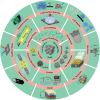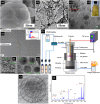Recent Advances in the Synthesis, Optical Properties, and Applications of Fluorescent Silicon Carbide Quantum Dots
- PMID: 40837049
- PMCID: PMC12362766
- DOI: 10.1002/smsc.202500013
Recent Advances in the Synthesis, Optical Properties, and Applications of Fluorescent Silicon Carbide Quantum Dots
Abstract
Earth-abundant, fluorescent silicon carbide (SiC) quantum dots (QDs) have recently attracted remarkable attention on account of their long-term chemical and optical stability and impressive biocompatibility. However, there has been a long-standing debate among researchers concerning whether radiative recombination in SiC QDs is governed by quantum confinement effects or by surface-related states. Herein, the underlying mechanism responsible for the photoluminescence observed in SiC QDs is elucidated. Significant progress made through the development of advanced strategies for synthesizing ultrasmall SiC QDs and modifying their surfaces with functional groups, conjugated molecules, and protective shells is discussed. Subsequently, the potential for engineered SiC QDs to be applied to a range of sectors, including energy (photocatalytic-based CO2 reduction systems), electronics/optoelectronics (electroluminescent white light-emitting diodes, nonlinear optics, and quantum sensing), and biomedicine (cell imaging and biosensors), is reviewed. Finally, this review is summarized with some forward-looking challenges and prospects.
Keywords: fluorescent quantum dots; optical properties; optoelectronic and biomedical and energy applications; silicon carbide; surface modifications.
© 2025 The Author(s). Small Science published by Wiley‐VCH GmbH.
Conflict of interest statement
The authors declare no conflict of interest.
Figures





















References
-
- Yi A., Wang C., Zhou L., Zhu Y., Zhang S., You T., Zhang J., X. Ou , Appl. Phys. Rev. 2022, 9, 0312.
-
- Blevins J. D., IEEE Trans. Semicond. Manuf. 2020, 33, 539.
-
- Papanasam E., Prashanth Kumar B., Chanthini B., Manikandan E., Agarwal L., Silicon 2022, 14, 12887.
-
- Feng Z. C., Lin H. H., Xin B., Tsai S. J., Saravade V., Yiin J., Klein B., Ferguson I. T., Vacuum 2023, 207, 111643.
Publication types
LinkOut - more resources
Full Text Sources
